The sustainable fashion movement has gained remarkable momentum in 2025, with more brands and consumers alike prioritizing eco-conscious practices and ethical production. As environmental concerns continue to shape global discussions, fashion industry leaders are increasingly adopting sustainable practices, from using eco-friendly materials to embracing transparency in their supply chains. The shift towards sustainability isn’t just a passing trend—it’s a transformative movement that is reshaping how clothes are designed, made, and consumed.
At the forefront of this change are established brands like Patagonia and Stella McCartney, as well as a growing number of new industry players committed to sustainability. These brands have recognized the importance of reducing the fashion industry’s impact on the environment and are leading by example. Patagonia, known for its commitment to environmental activism, has long been a leader in sustainable fashion. In 2025, the brand continues to innovate with the use of recycled materials in its outdoor gear and clothing, and its focus on fair labor practices remains central to its mission. Patagonia’s repair and reuse programs also encourage consumers to extend the life of their garments, reducing waste and promoting a circular approach to fashion.
Similarly, Stella McCartney has long been synonymous with ethical fashion. In 2025, the brand has further expanded its use of plant-based and recycled fabrics, making strides in both innovation and luxury. McCartney’s dedication to eliminating the use of animal-derived materials and minimizing waste sets a high standard for sustainable luxury fashion. The designer has also incorporated biodegradable alternatives into her collections, contributing to a more sustainable future for high-end fashion.
In addition to these influential names, a wave of new, eco-conscious brands has emerged, offering fresh alternatives to fast fashion. These companies are focusing on ethical production methods, sourcing sustainable fabrics like organic cotton, hemp, and Tencel, and working with artisans to create unique, high-quality pieces. Many of these newer brands emphasize transparency in their supply chains, allowing consumers to trace the origins of their garments and understand the environmental and social impact of their purchases. For these emerging brands, sustainability isn’t just a marketing tool—it’s embedded in their core values, and it resonates with a growing base of conscious consumers.
One of the most significant trends in sustainable fashion is the rise of second-hand clothing, upcycling, and circular fashion. As consumers become more aware of the environmental impact of their purchasing habits, there has been a notable shift towards buying pre-loved items or repurposing existing clothing. Online platforms like Depop, ThredUp, and Poshmark have become integral to this movement, offering a marketplace for second-hand and vintage clothing. These platforms not only make it easier to access sustainable options but also encourage a mindset shift—one where the value of clothing is no longer determined by its novelty but by its longevity and uniqueness.
Upcycling, the process of repurposing old or discarded clothing into new, wearable pieces, is also gaining traction. Designers are increasingly using upcycled fabrics and materials to create new collections, contributing to a reduction in textile waste. Circular fashion models, where clothes are designed to be recycled, reused, or repaired at the end of their life cycle, are becoming more popular. Brands like Patagonia and the Swedish retailer, H&M, have introduced take-back schemes where consumers can return their old garments to be repurposed or resold, further promoting a closed-loop system.
The growing demand for sustainable fashion is also influencing traditional fast fashion brands to rethink their practices. Companies like Zara, H&M, and ASOS are investing in more sustainable production methods, incorporating recycled materials into their collections, and expanding their range of eco-friendly options. While these brands still face criticism for their environmental impact, their shift towards sustainability reflects the broader pressure on the fashion industry to adapt to changing consumer preferences.
For consumers, the rise of sustainable fashion represents a powerful opportunity to make more informed choices. In 2025, shoppers are increasingly prioritizing brands that align with their values, demanding greater transparency and accountability from the companies they support. The growing availability of eco-conscious alternatives means that sustainable fashion is no longer just the domain of a niche market. It is becoming a mainstream movement, one that reflects a collective desire to reduce waste, support ethical labor practices, and protect the planet.
The future of fashion is undeniably more sustainable, with brands leading the way in the shift towards ethical production, eco-friendly materials, and transparency. As this movement continues to gain momentum, the fashion industry is undergoing a fundamental transformation, one that puts the planet and its people at the heart of design and production. In 2025, sustainable fashion is no longer just a trend—it is the future, and it is shaping a more conscious, responsible approach to style.


